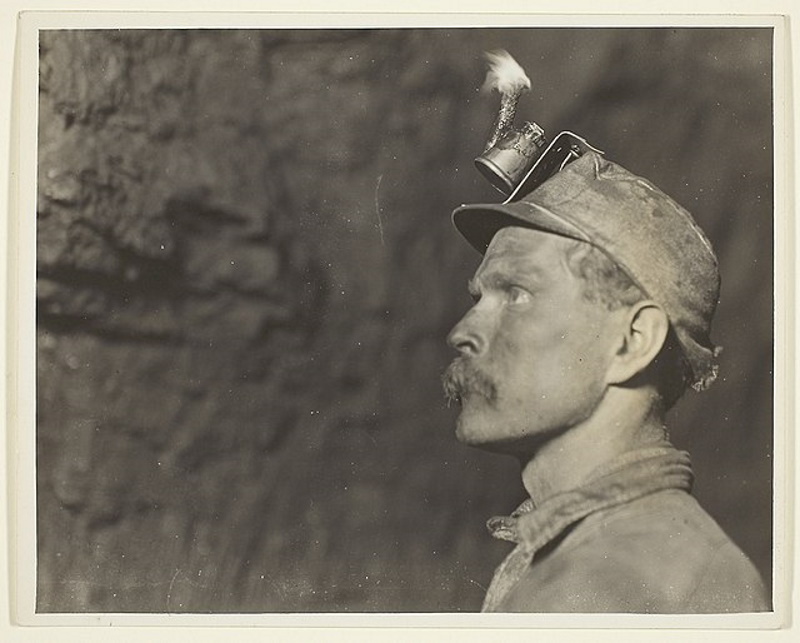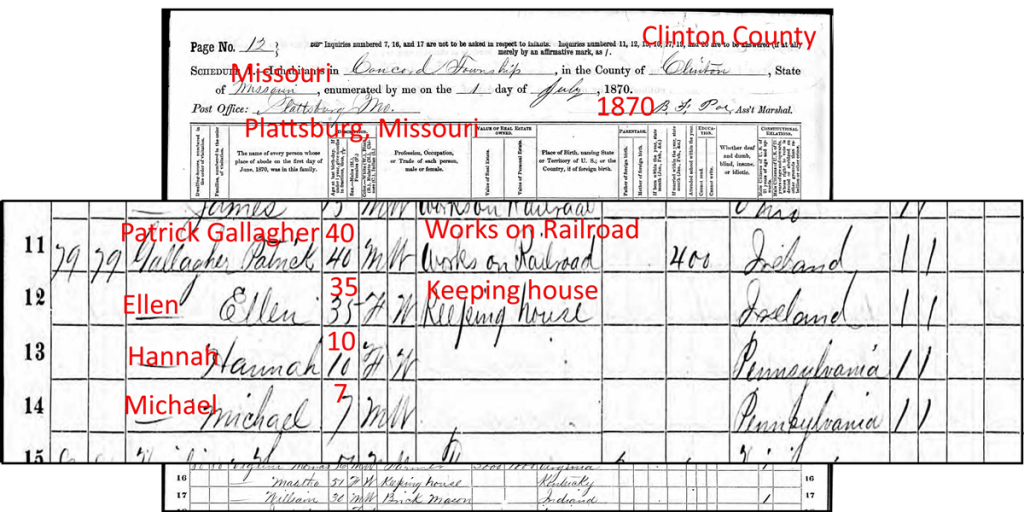During the Civil War, anthracite coal was crucial to the Union. Many of the mine workers didn’t serve in the military, as coal was a critical industry to support the war effort. The owners pressured the workers for increased production.
The Gallaghers and Larges and Kellys labored on.

The Civil War Years
The nations military looked to the anthracite region to supply its armories with coal. The Union Navy favored Eckley’s coal, and it was burned by the ironclad Monitor in its famous battle with the South’s Merrimack in March 1862. Only one year earlier, a ton of coal was selling for $2.10; by 1864, a ton fetched $6.25.
A Jewel in the Crown of Old King Coal: Eckley Miners’ Village
Stay or go?
In 1865, the Civil War was over. Patrick Gallagher had worked in the coal mines for fifteen years. He was a coal mine laborer. He had a terrible job.
At the end of each month his family was probably no better off than the month before. But still, it was a job. It provided housing and food. But it was a terrible job.

Maybe Patrick suffered health problems caused by the mines. Maybe the likelihood of injury or death was on his mind. Patrick and Ellen were considering a change.
Perhaps their decision was influenced by the death of Ellen’s mother Bridget Large. Bridget had lived in the household of her daughter Margaret (Large Kelley), just a few houses away from her daughter Ellen (Large Gallagher). Maybe Bridget’s death in the late 1860’s influenced Ellen and Patrick’s decision to leave Eckley.
Patrick and Ellen realized that coal mine labor didn’t offer better opportunities for their children. Patrick had a terrible job.
Whatever their rationale, Patrick and Ellen Gallagher made the decision to leave Eckley and coal mining. They would answer the clarion call to “go west.”
Go West
As we saw in earlier stories, railroad expansion had stopped during the Civil War. Sedalia, Missouri was the western terminus.
Now, after the war, one of the biggest industries was western railroad expansion. The railroads were hiring out west, and Irish workers were moving there for jobs.

Railroad construction had stalled in western Missouri and eastern Kansas during the war. Now, it was the epicenter of activity. Competition was fierce. Which railroad would cross the Missouri River and span Kansas or Nebraska on the way to the Pacific? Which cities would be lucky enough to host a railroad depot?
Plattsburg, Missouri
One railroad hotbed was Plattsburg, Missouri. Plattsburg was the county seat of Clinton County, 30 miles north of Kansas City. Like many other young cities and counties in the west, the people of Plattsburg feared they would be overlooked by the railroad.

The residents took their case directly to the railroads, the St. Louis & St. Joseph, and the Chicago & Southwestern. It was agreed that if Buchanan, Clinton, and Ray Counties would subscribe stock to the amount of $775,000, the railroads could be built.
The election was held on Tuesday, the 4th day of February 1868.
It was near 11 o’clock when George Essig arrived from Cameron bringing with him the official vote, which was unanimous for the railroads. In a few minutes every bell in town was ringing – hats and caps were thrown up, and the people were fairly wild with joy.
The History of Clinton County, Missouri – 1881
Construction began in earnest. Roadbeds would be laid. Bridges and trestles and drainage would be built. Track and depots and maintenance buildings would follow. The railroads begged for workers.
One of those new railroad workers was Patrick Gallagher, recently arrived from Pennsylvania.
Plattsburg, Missouri 1870
How and why did Patrick and Ellen Gallagher and family end up in Plattsburg, Missouri? Did they follow some co-worker from Eckley? Was it just chasing a job? We don’t know.
The 1870 census listed lots of railroad workers in Plattsburg, mostly Irish-born.
The 1870 census listed Patrick Gallagher, 40, and Ellen, 35, living in Plattsburg, Missouri. Neither could read or write. Daughter Hannah was age 10, Michael was 7.

Patrick worked on the railroad, perhaps laying track or building infrastructure. Many Irish railroad workers lived nearby.

One of these roads, now the Wabash, St. Louis, and Pacific, was finished in July 1870
People from the town and country were all gathered at the bridge, the memorable spot where the last stroke was to be made. The last connecting rail was left by the tracklayers unspiked. Colonel Gower, Mayor Ingles and Rev. Father O’Riley each then gave the spike two home licks.
The train soon whistled into Plattsburg, and then away it went to St. Joseph, carrying its freight of enterprising and sociable men.
The History of Clinton County, Missouri – 1881
The other road, now called the Chicago, Rock Island & Pacific, was finished in 1871. When completed, a grand excursion came over the road, from Chicago and Leavenworth. The excursionists were composed of invited guests, from four different states, among whom were Generals Grant, Beauregard, and several members of the United States Senate, and Congress.
The History of Clinton County, Missouri – 1881

You can see in this railroad map that Plattsburg and surrounding counties held the junctions of several railroad lines.
The city of Plattsburg also served as a railroad center. It is where depots were created to serve branch lines of the St. Louis, Kansas City, Hannibal & St. Joseph Railroads, back in 1871.
Plattsburg, an historic destination in Clinton County, Missouri

What next?
The last spikes of Clinton County railroads were driven in 1871. Railroad expansion moved westward. Would Pat and Ellen Gallagher follow?
Land for sale
The railroads were granted huge tracts of land with their right-of-way agreements. The goal was to encourage settlements as the roads moved westward. The railroads vigorously promoted the land sales.

It was a dream for many immigrants to own a home and farm. Perhaps these land promotions beckoned Pat and Ellen.
Timeline

Sources
- Quotation – Eckley coal in the Civil War – A Jewel in the Crown of Old King Coal: Eckley Miners’ Village – Pennsylvania Heritage – https://paheritage.wpengine.com/article/jewel-crown-old-king-coal-eckley-miners-village/
- Image – Miners at work in the Coal Region, ca. 1865 – Harper’s Weekly – Wynning History – A NEW YORK TIMES REPORTER DOCUMENTS THE TURBULENT SITUATION IN THE COAL REGION – 1863 – https://wynninghistory.com/2020/05/17/ny-times-1863-1/
- Image – Bill Keating – Tuscarora –
- Quotation – Plattsburg, an historic destination in Clinton County, Missouri – Lisa C. – http://plattsburgmo.com/plattsburg-historic-destination-clinton-county-missouri/
- Quotation – Bringing the railroads to Plattsburg – The History of Clinton County, Missouri – 1881 – Library of Congress – https://tile.loc.gov/storage-services/public/gdcmassbookdig/historyofclinton00stjo/historyofclinton00stjo.pdf
- Census – Patrick and Ellen Gallagher family – 1870 – ancestry.com – https://www.ancestry.com/imageviewer/collections/7163/images/4273246_00016?pId=1999372
- Map – Plattsburg area of NW Missouri – 1866 – Map Geeks – https://mapgeeks.org/missouri/#!fancybox/a65a901b/1866-Map-of-Missouri-Public-Survey-Sketches-by-the-Department-of-Interior-Land-Office.jpg
- Map – Clinton County, Missouri railroad map – 1904 – mygenealogyhound.com – https://www.mygenealogyhound.com/maps/missouri-maps/mo-clinton-county-missouri-1904-map.html
- Image – Sectional Maps Showing the Exact Location of Over 300,000 Acres Selected Prairie, Timber and Coal Lands in Northern Missouri, 1868 – https://dl.mospace.umsystem.edu/umsl/islandora/object/umsl%3A332384#page/38/mode/2up
- Music – West Fork Gals – Shake That Little Foot – Free Music Archive – https://freemusicarchive.org/music/Shake_That_Little_Foot/
- Music – An excerpt from Rail Dynamics – Smithsonian Folkways – https://folkways.si.edu/an-excerpt-from-rail-dynamics/american-folk/music/track/smithsonian
Sad to see them leave NE PA. This post made me think of how many times our ancestors had to leave their homes, never to see family members and friends again. Ireland to America was not the last of their journeys. After the coal country, Cathy’s ancestors went west, while mine became city dwellers in Philadelphia. New roots for each branch!
LikeLike
For sure. And wouldn’t you love to ask them – Why there? How did you move? Did you take “stuff” with you? What did you think your future would be? And more…
LikeLiked by 1 person